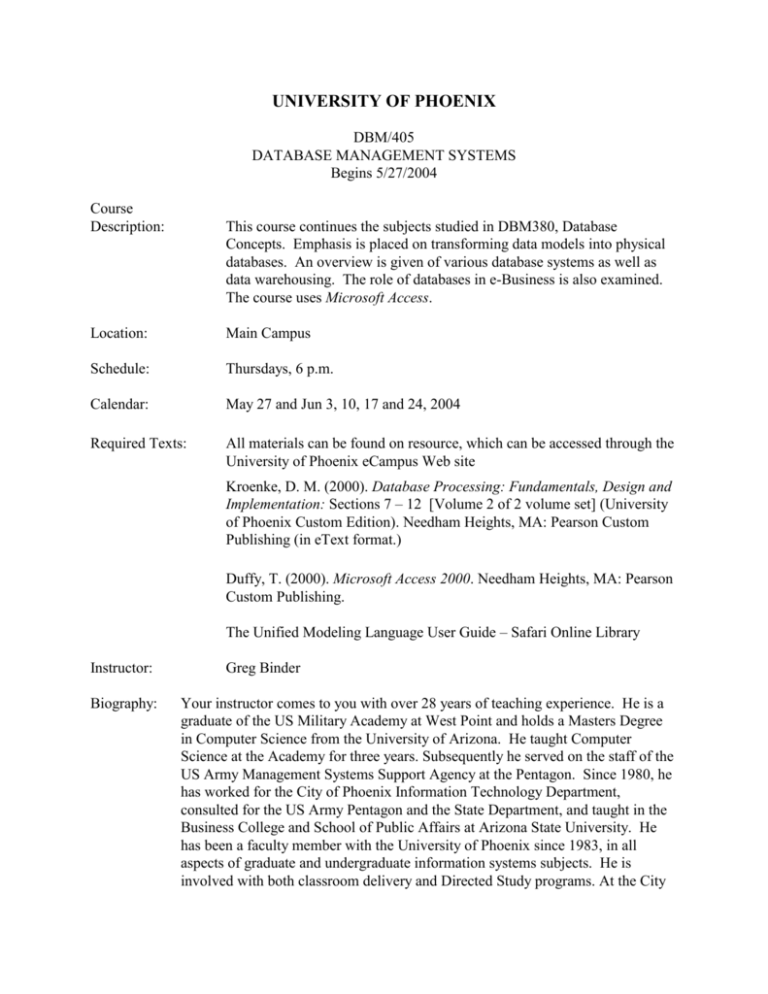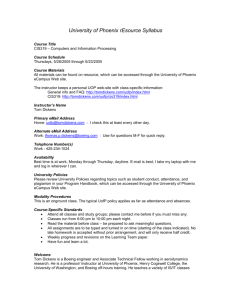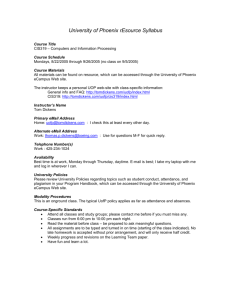UNIVERSITY OF PHOENIX
advertisement

UNIVERSITY OF PHOENIX DBM/405 DATABASE MANAGEMENT SYSTEMS Begins 5/27/2004 Course Description: This course continues the subjects studied in DBM380, Database Concepts. Emphasis is placed on transforming data models into physical databases. An overview is given of various database systems as well as data warehousing. The role of databases in e-Business is also examined. The course uses Microsoft Access. Location: Main Campus Schedule: Thursdays, 6 p.m. Calendar: May 27 and Jun 3, 10, 17 and 24, 2004 Required Texts: All materials can be found on resource, which can be accessed through the University of Phoenix eCampus Web site Kroenke, D. M. (2000). Database Processing: Fundamentals, Design and Implementation: Sections 7 – 12 [Volume 2 of 2 volume set] (University of Phoenix Custom Edition). Needham Heights, MA: Pearson Custom Publishing (in eText format.) Duffy, T. (2000). Microsoft Access 2000. Needham Heights, MA: Pearson Custom Publishing. The Unified Modeling Language User Guide – Safari Online Library Instructor: Biography: Greg Binder Your instructor comes to you with over 28 years of teaching experience. He is a graduate of the US Military Academy at West Point and holds a Masters Degree in Computer Science from the University of Arizona. He taught Computer Science at the Academy for three years. Subsequently he served on the staff of the US Army Management Systems Support Agency at the Pentagon. Since 1980, he has worked for the City of Phoenix Information Technology Department, consulted for the US Army Pentagon and the State Department, and taught in the Business College and School of Public Affairs at Arizona State University. He has been a faculty member with the University of Phoenix since 1983, in all aspects of graduate and undergraduate information systems subjects. He is involved with both classroom delivery and Directed Study programs. At the City of Phoenix Mr. Binder manages development of the e-government (e-commerce and e-privacy) program, and web-based applications systems development as major assignments. Telephone/Mail Home: 15437 N 2nd Ave Phoenix, AZ 85023 (602) 942-6448 (H) (602) 256-3589 (W) Office: Electronic Mail Address: gbinder@email.uophx.edu gbinder69@qwest.net gbinder@phoenix.gov Web Site: http://www.users.qwest.net/~gbinder69/ Availability: I can be reached by any means above. In many cases, you will have to leave a message, however, I will return your contact as soon as possible. You may call the work number at any time. Home calls should be limited to 7 a.m. to 10 p.m. For sending documents by e-mail, use the following address: gbinder@email.uophx.edu Assignments: This syllabus interprets and changes the homework assignments in the module. Use this syllabus as your guide to the nature of graded assignments. Please do not be misled: you are responsible for the material in the assignments. The following specific guidelines are provided: The Learning Team will be used as a major vehicle in the various class activities, both during workshops and in outside assignments. Established teams will be modified to accommodate changed in class enrollment. As with many University courses, class participation is a valued attribute, contributing to the final grade. Several other measures of student performance are noted in the Grading Criteria. Grading: % 95-100 91-94+ 87-90+ 83-86+ 80-82+ 78-79+ Grade A AB+ B BC+ % 75-77+ 72-74+ 68-71+ 65-67+ <65 Please remember: A= Excellent performance. Grade C CD+ D F B= C= D= F= Above average performance Average performance. Accomplishes only the minimum requirements. Oral and written communication is at an acceptable level for an under- graduate student. Meets minimally acceptable levels of performance. Does not meet the most minimal requirements of the course. All written work (does not include homework questions) will be according to APA or MLA guidelines. Your grade will be based on style, content and format including such items as clarity of communication, sentence and paragraph construction, punctuation, spelling, and grammar. Late cannot be accepted. If you are unable to complete the coursework you should seek guidance from your academic counselor - as a matter of University policy, incompletes are not granted. Course Standards: Please review University Policies regarding topics such as student conduct, attendance, and plagiarism in your Program Handbook, which can be accessed through the University of Phoenix eCampus Web site. The University of Phoenix Adult Teaching Learning Model is based on the assumption that in preparation for every course, students will satisfy all prerequisites. During the course itself, students will achieve certain learning outcomes. All performance assessment depends upon the accomplishment of these outcomes. Students are graded on achievement, rather than effort. It is the responsibility of the student to come to class prepared for each workshop. Academic Honesty: The University trusts that each student will maintain high standards of honesty and ethical behavior. All assignments submitted in fulfillment of course requirements must be the student's own work. All assignments except those designated as "team" are meant to represent the effort of each individual student. Team projects and assignments should represent equal efforts by all team members. Academic honesty is highly valued at the University of Phoenix. Students must always submit work that represents their original words or ideas. If any words or ideas used in a class posting or assignment submission do not represent the student’s original words or ideas, all relevant sources must be cited along with the extent to which such sources were used. Words or ideas that require citation include, but are not limited to, all hard copy or electronic publications, whether copyrighted or not, and all verbal or visual communication when the content of such communication clearly originates from an identifiable source. Please see the University of Phoenix Catalog for more information about academic honesty, including consequences of academic dishonesty. Privacy and Confidentiality in the University of Phoenix Classroom: One of the highlights of the University of Phoenix academic experience is that students can draw on the wealth of examples from their organizations in class discussions and in their written work. However, it is imperative that students not share information that is confidential, privileged, or proprietary in nature. Students must be mindful of any contracts they have agreed to with their companies. Attendance: Attendance at all class sessions is mandatory. Absences: If an absence is necessary, the student must contact the faculty member. Second absences are not allowed. Please note: An absence may affect the student's grade. Other: During the following workshops, graded activities will be conducted (with point value indicated): ASSIGNMENTS POINTS SCORING 45 45 30* (presentation) 30* (presentation) 30* (presentation 30 45 45 Individual Week Two Assignment (Workshop Two) – write a 2 – 3 page paper (350 words per page) that explains what UML is and how it relates to databases. Week Two Assignment (Workshop Two) – Using Microsoft Access, create and link the tables for the inventory model from DBM/380.* Week Three Assignment (Workshop Three) - Using Microsoft Access, create input forms for the inventory database.* Using Microsoft Access, create reports for the inventory database.* Week Four Assignment (Workshop Three) - Thoroughly explain the following: 1. OLAP 2. data warehouses. 3. data marts Team Presentation (Workshop Five) – This is an individual grade for the presentation part of the team project. Participation (All Workshops – 35/15 split – classroom/learning team) 45 45 40 40 Learning Team Team Product (Workshop Three) – Each Learning Team will submit a UML Use Case for the selected inventory system.. 45 45 Team Paper (Workshop Five) – Each Learning Team will submit a completed Class Diagram for the selected inventory system. 45 45 Optional Learning Team Project - see description below 45 Total 45 250 * Each member of the class will elect to make one of these presentations regarding his or her design. INDIVIDUAL ASSIGNMENTS Week One Complete assignments posted on the rEsource course page. Discussion Question(s): Why do we see the Entity-Relationship model used more than the Semantic Object model? Week Two Discussion Question(s): Why has the use of databases increased dramatically? Using Microsoft Word write a 2 – 3 page paper (350 words per page) that explains what UML is and how it relates to databases. Using Microsoft Access, create and link the tables for the inventory model from DBM/380. Depending on which version of Microsoft Access you have, there are two references in the Safari Online Library for which you can refer: “10 minute Guide to Microsoft Access 2002” and “Visual Quickstart Guide to Access 2000 for Windows.” Week Three Discussion Question(s): What is the relationship among ODBC, OLE DB, and ADO? Using Microsoft Access, create input forms for the inventory database. Week Four Discussion Question(s): What is the relationship of “tier” in “three-tier architecture” and “tier” in ODBC? What are the different ways databases can be accessed in Web sites? Write a short paper explaining: OLAP Data Warehouse and Data Mart Three-tier architecture ASP Using Microsoft Access, create queries for the inventory database. Week Five Discussion Question(s): In what ways has the Web changed how databases are used? Using Microsoft Access, create reports for the inventory database. Complete a Learning Team Evaluation. OPTIONAL LEARNING TEAM PROJECT This is the project: Problem Computer Sciences Department frequent fliers have been complaining to Dane County Airport officials about the poor organization at the airport. As a result, the officials have decided that all information related to the airport should be organized using a DBMS, and you've been hired to design the database. Your first task is to organize the information about all the airplanes that are stationed and maintained at the airport. The relevant information is as follows: _ Every airplane has a registration number, and each airplane is of a specific model. The airport accommodates a number of airplane models, and each model is identified by a model number (e.g., DC10) and has a capacity and a weight. _ A number of technicians work at the airport. You need to store the name, SSN, address, phone number, and salary of each technician. _ Each technician is an expert on one or more plane model(s), and his or her expertise may overlap with that of other technicians. This information about technicians must also be recorded. _ Traffic controllers must have an annual medical examination. For each traffic controller, you must store the date of the most recent exam. _ All airport employees (including technicians) belong to a union. You must store the union membership number of each employee. _ You can assume that each employee is uniquely identified by the Employee Number. _ The airport has a number of tests that are used periodically to ensure that airplanes are still airworthy. Each test has a Federal Aviation Administration (FAA) test number, a name, and a maximum possible score. _ The FAA requires the airport to keep track of each time that a given airplane is tested by a given technician using a given test. For each testing event, the information needed is the date, the number of hours the technician spent doing the test, and the score that the airplane received on the test. Here are the specific tasks you have to address based on the above information: 1. Design a conceptual database schema (aka Entity-Relationship Diagram) for Dane County Airport according to the above information needs. Try to use simple attribute types whenever possible. In case of a complex attribute type, you can model this as an entity type. Be sure to indicate primary key attributes for each entity type! For each relationship type, clearly specify the semantics of a relationship type using the (min,max) notation. Make only use of the modeling concepts discussed in DBM380 (e.g., don't use weak entity types). Also, you don't have to specify the data types for the attributes. 2. Identify (reasonable) constraints that you are unable to capture using the ER modeling constructs. State them in natural language (plain English). For each constraint, give a brief explanation why you need the constraint and why you cannot express it in the ER schema, e.g., using cardinalities etc. 3. Identify all the tables you can derive from your ER diagram. For each table, list all attributes. For which relationship type(s) don’t you don't need a table? 4. The FAA passes a regulation that tests on a plane must be conducted by a technician who is an expert on that model. How would you express this constraint in the ER diagram? If you cannot express it, explain briefly. 5. Based on the problem statement, your learning team can design data entry screens and reports, so as to build a basic Access application to support this business function. Details of this requirement will be discussed in class. Grading for Written Work 50% Content/Development All key elements of the assignment are covered in a substantive way Content is comprehensive, accurate, and/or persuasive Major points are stated clearly, are supported by specific details, examples, or analysis and are organized clearly Where appropriate, the paper supports major points with theory relevant to development of the ideas, and uses the vocabulary of the theory correctly There is integration of theory and practice whereby the writer is able to link theories to practical experience Research is adequate and timely for the topic The context and purpose of the writing is clear 20% Organization The structure of the paper is clear and easy to follow The paper’s organization emphasizes the central theme or purpose and is directed Paragraph transitions are present and logical, and maintain the flow of thought throughout the paper The conclusion is logical and flows from the body of the paper The conclusion reviews the major points toward the appropriate audience Ideas flow in a logical sequence The introduction provides sufficient background on the topic and previews major points 10% Format The paper, including citations and the reference page, follows designated guidelines for format The paper is laid out effectively and uses reader-friendly aids (e.g., sections, summaries, tables of contents, indices, appendices, etc.) when appropriate The paper utilizes references appropriately Headings, the use of italics, etc., aid the readability of the paper and are not overdone The paper is neat, with attention given to format requirements Original work 10% Grammar/Punctuation/Spelling Rules of grammar, usage, and punctuation are followed Spelling is correct 10% Readability/Style Sentences are complete, clear and concise Sentences are well-constructed with consistently strong, varied structure Sentence transitions are present and maintain the flow of thought Words used are precise and unambiguous The tone is appropriate to the content and assignment Grading for Oral Presentations 20% Organization and Structure Presentation is well-organized, clear, and effectively structured If this is a team presentation, it is integrated rather than a disjointed series of individual presentations Topic is researched adequately 10% Effective Use of Visual Aids Visual aids are clear and effective Visual aids contribute to a focused and integrated presentation 50% Content of Presentation Content of presentation clearly follows the written paper on which it is based (if applicable) The topic is relevant and addresses the specifications of the assignment The content presented is comprehensive, accurate and believable Key points are noted and presented logically 10% Style, Presentation, and Appearance Dress and grooming are professional and appropriate for the setting Non-verbal gestures are appropriate to the purpose of the presentation and flow of ideas Confidence and knowledge of content are evident Audience is engaged, when appropriate, in a professional manner Delivery time is used well-presentation is not rushed Speaker adheres to the time limit 10% Questions and Comments Audience feedback is solicited Audience questions are effectively addressed and correctly answered





